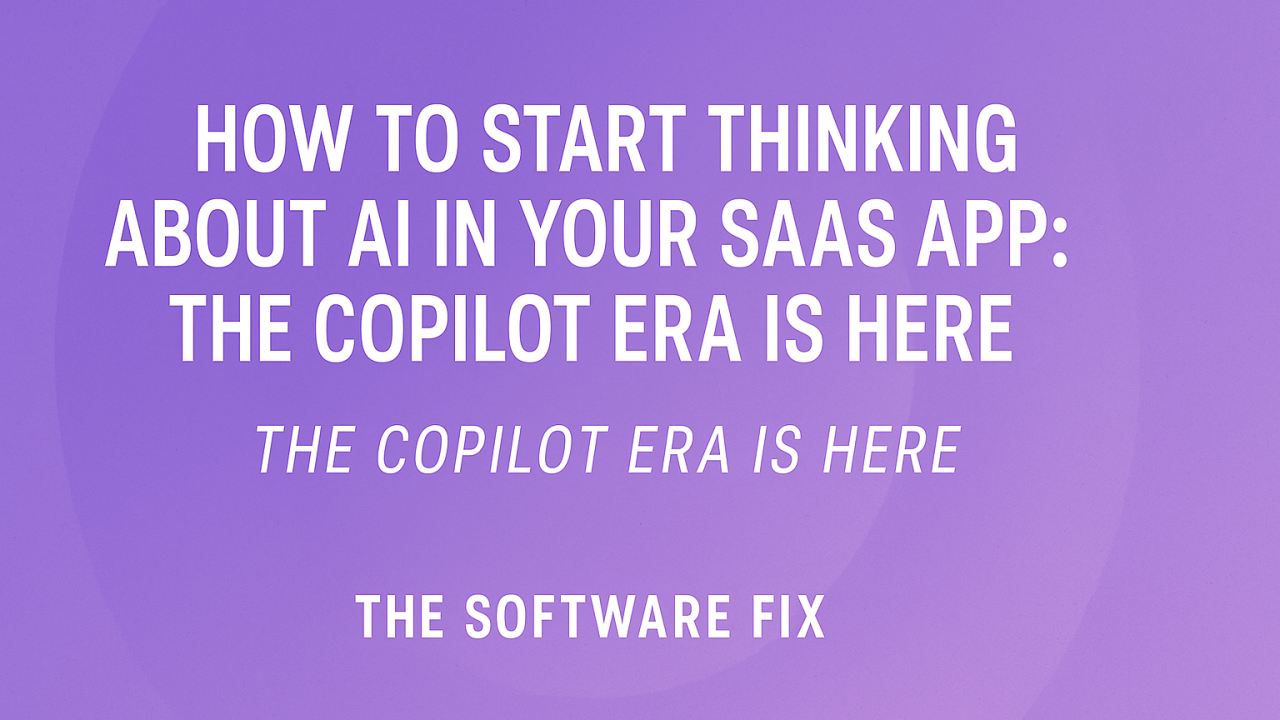How to Start Thinking About AI in Your SaaS App: The Copilot Era Is Here

Customer-facing AI isn’t just chatbots anymore. It’s a paradigm shift — and your SaaS product should be ready.
AI is no longer a “nice to have” or a futuristic idea reserved for billion-dollar companies with sprawling R&D departments. It’s rapidly becoming a baseline expectation — not just behind the scenes, but in front of your customers, inside the software they use every day.
If you run or build a SaaS product, now is the time to rethink your roadmap through the lens of AI — not for novelty, but for actual customer impact.
The Shift: From Tickets to Transformation
For years, support teams have been reactive. A customer has a problem, they file a ticket, a human investigates and responds — sometimes too slowly. Meanwhile, many problems don’t even become tickets. Customers silently churn because a feature was too confusing, onboarding too opaque, or troubleshooting too manual.
Here’s where embedded AI steps in. Not as a bandage, but as a reimagining.
Imagine a world where your software proactively explains itself, corrects user errors, and even anticipates next steps — all within the app experience. Welcome to the era of the copilot.
What is a Copilot, Really?
Microsoft branded it, but the concept is bigger than any one company. A copilot is an AI-powered assistant that augments the user’s capabilities inside your product. It doesn't replace your UX — it enhances it.
It might:
- Guide users through a complex setup process using natural language prompts.
- Auto-fill forms with smart defaults based on past behavior.
- Detect when a user is stuck and surface contextual help — or summarize an issue before it even becomes a support ticket.
- Translate business intent into product actions: “Show me all unpaid invoices from the last 60 days.”
The result? Fewer support cases. Faster onboarding. Stickier users. Higher NPS.
Where to Start: Think Like Support
You don’t need to overhaul your entire product overnight. Start by asking your support team one question:
What do users struggle with most — even if they never complain?
Look for:
- Repeated friction points in onboarding.
- FAQs that people shouldn’t have to ask.
- Usage patterns where drop-off happens consistently.
- Power-user features that only 5% of your base ever figure out.
Then ask: Could we surface help, automate a workflow, or provide smart suggestions at this moment?
This is fertile ground for embedded AI.
Real-World Examples
- Customer education: Instead of static documentation, embed a conversational layer that answers “How do I…?” inside the UI.
- Data cleanup: Let users fix bad data with natural language — e.g., “Remove duplicate contacts from my list.”
- Reporting: Use AI to summarize dashboards or generate custom reports based on plain-English questions.
- User productivity: Predict what a user wants to do next and offer one-click shortcuts or draft content automatically (think: CRM notes, email replies, meeting follow-ups).
Rethinking the Product Team’s Role
In the past, product design was about reducing friction. Now, it’s also about adding intelligence — building a product that adapts to each user’s needs in real time.
That means designers, engineers, and support leaders must collaborate more closely. AI-powered experiences blur the lines between UX, customer success, and technical support.
In the past, product design was about reducing friction. Now, it’s also about adding intelligence
It also means you need the right infrastructure: a clean data model, user event tracking, and a way to safely expose AI-generated insights or actions without confusing or overwhelming users.
Don’t Let the Hype Scare You
Yes, AI is a buzzword. Yes, implementation is hard. But you don’t need a research lab to get started. Use existing APIs (OpenAI, Anthropic, Cohere, etc.) or low-code platforms to test simple use cases. Start with one customer-facing feature that saves time or reduces confusion.
Then measure its impact. Did support tickets drop? Did usage increase? Did users say “this is cool” without being prompted?
If so, you’re onto something.
Bottom Line: AI is the New UX
In 2025 and beyond, the best SaaS products won’t just be intuitive — they’ll be intelligent. And that intelligence will live inside the interface, not just behind the scenes.
The companies that win will be the ones who stop thinking of AI as a backend feature and start thinking of it as a front-seat driver — a copilot — helping customers get to value faster than ever before.
The question isn’t whether your app should have a copilot. It’s what kind — and how soon.

